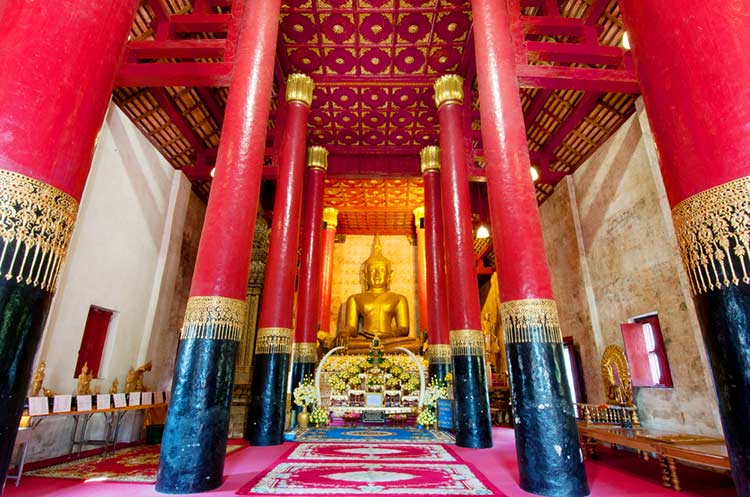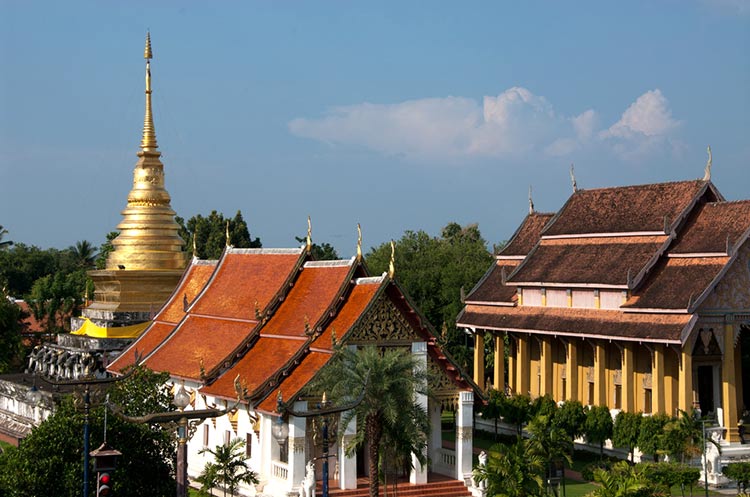
Wat Phra That Chang Kham
15th Century temple with the largest scripture library in Thailand
Nan
In the center of Nan town is the Wat Phra That Chang Kham, one of Nan’s oldest and most important temples. This temple dating back to the early 15th century is locally known as the Wat Chang, meaning “Elephant Temple”. Its architectural style is a mix of Lanna and Thai Lü styles.
Viharn built in 1458
The attractive viharn was rebuilt in 1458. Its front façade is very elegantly decorated with gold motifs on a blue background. Chofah in the form if stylized Naga serpents adorn the ends of the multi tiered roof. The viharn’s entrance is guarded by two white lions. In the interior two rows of large red and black teak columns, support the roof.
The viharn’s ancient Buddha images and palm leaf scrolls
The viharn contains a number of important and very old Buddha images.
Lanna style Buddha
The principal image is a large Lanna style seated image in the Bhumisparsha mudra named Phra Chao Luang. Flanking the image are two ancient Sukhothai style Buddha images, that were cast in 1426.
Murals mostly gone
Unfortunately the 19th century murals were whitewashed during the previous century. Some of them can still be made out through the paint.
Ancient palm leaf scrolls
The viharn contains a number of ancient scrolls written on palm leaf. Some of them contain scripts with the teachings of the Buddha, others contain texts about history and law in the time of King Mengrai, King of the Lanna Kingdom around the early 14th century.
Heavily decorated Dhamma seat
In one of the viharn’s corners is a heavily decorated thammdat chair or Dhamma seat, a chair used by the monks when teaching.
The Ho Trai, the Buddhist scripture library
Next to the viharn is the largest ho trai in Thailand. Although not in use as a library anymore, a ho trai is the temple’s library that stores the Tripitaka, the scriptures containing the teachings of the Buddha.
The Rattanakosin style ho trai has a multi tiered roof supported by impressive columns around the structure. Next to the stairs leading to the entrance are two lions guarding the huge building. At the center of the front gable is a large Garuda, a bird from Buddhist mythology. On the back wall of the otherwise empty ho trai is a golden walking Buddha image in the Sukhothai style kept in a golden and red wooden show case.

Chedi supported by elephants
Probably the oldest structure of the Wat Phra That Chang Kham is the chedi, located behind the viharn. Built in 1406, the stupa is a mix of Sukhothai and Lanna styles. It has a square base with a gilded spire. The chedi appears to be supported by 24 elephant statues protruding out of its base, similar to several “elephant encircled chedis” of the Sukhothai Historical Park and the chedi of the Wat Chiang Man temple in Chiang Mai.
Other structures
Other structures on the temple grounds are a smaller white chedi, a bell tower, a small simple ubosot without windows and the kuti, the monks living quarters.
How to get to the Wat Phra That Chang Kham
The temple is found on the intersection of Mahaprom road and Pha Kong road opposite the Nan National Museum in downtown Nan. It is near two other Nan temples, the Wat Phumin and Wat Hua Khuang.
From most downtown Nan hotels, the temple can be reached on foot. Alternatively, charter a songthaew to get you there.
Opening hours
The temple grounds are open during daylight hours, from about 6 am until 6 pm.
Entrance fee
Admission is free.
- Wat Ton Laeng
- Wat Hua Khuang
- Wat Phra That Chang Kham
- Wat Phra That Chae Haeng
- Wat Phumin
- Wat Suan Tan
- Wat Phaya Wat